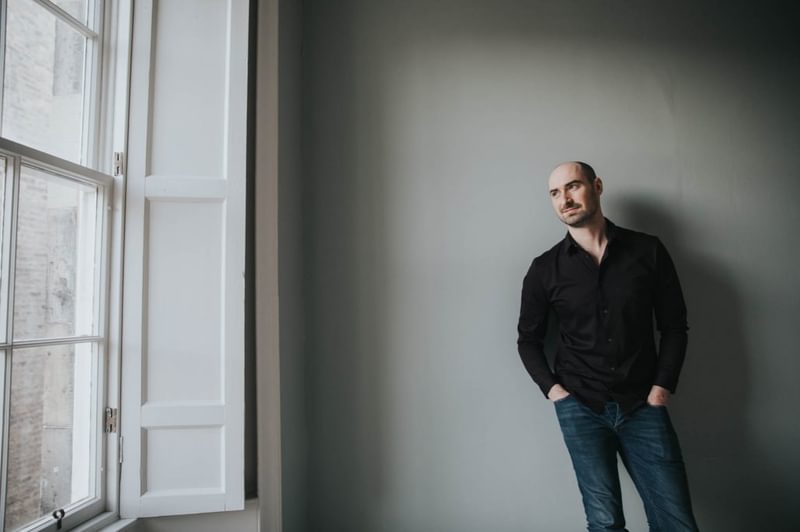Peter Whelan conductor
Joseph Haydn (1732-1809)
Symphony No 83 in G minor, Hob 1:83, 'La poule'
Allegro
Andante
Minuet – Trio
Finale. Vivace
Wolfgang Amadeus Mozart (1756-1791)
Symphony No 39 in E flat, K 543
Adagio – Allegro
Andante con moto
Menuetto. Allegro – Trio
Finale. Allegro
All performers at this event are conforming to our safety requirements of being at least two metres apart.
The development of the symphony is inextricably bound up with the changing role of the composer. Many of Haydn’s compositions were written for his employer, Nikolaus Esterházy, including much operatic music, as well as chamber music featuring the Prince’s favourite instrument, the now obscure baryton. When Nikolaus’s son Anton succeeded him in 1790, cuts to the musical establishment led to Haydn having more freedom to work for other venues and benefactors. Haydn remained attached to the Esterházys, receiving a pension until his death in 1809. Less frequently composing to order and more frequently writing to commission led to greater freedom and a more expansive style within Haydn’s music.
Joseph Haydn’s six ‘Paris’ symphonies (Nos 82 to 87) were written to a 1785 commission from the Masonic organisation ‘Le Concert de la Loge Olympique’. Although written while he was still in Nikolaus’s employ, he was able to take advantage of the grander forces available at the Freemasons’ disposal. The financial and cultural reach of Freemasonry in the years before the French Revolution was significant (both Haydn and Mozart were Masons). In little more than a decade, however, Freemasonry was suppressed by the Habsburg emperor and the cultural appeal of the Lodge dwindled substantially.
The Symphony No 83 is written in the standard Classical four-movement form: a sonata-form first movement, followed by a slow movement and minuet, and concluding with a rambunctious Finale. It is known as ‘La Poule’ or ‘The Hen’ as a result of the jerky second theme in the first movement, reminiscent of a chicken’s waddle.
Unlike Haydn, Mozart was dismissed by his aristocratic employer, the Prince-Archbishop of Salzburg, and subsequently worked as a freelance composer in Vienna. His Symphony No 39 was written in 1788, alongside the fortieth and forty-first, to no commission. The musicologist Richard Taruskin guards against reading into this the nineteenth-century attributes of artistic autonomy, and of ‘absolute music’, preferring instead to see Mozart taking advantage of his own professional freedom to compose as he wished. This freedom, however, came at a price; infamously, Mozart died in destitution tragically young.
It is easy to conflate the undeniable quality of Mozart’s last three symphonies with some kind of ‘higher’ prophetic utterance, that these must a prelude for music to come. In reality, the four-movement structure is identical to Haydn’s and the work is roughly the same length as ‘La Poule’. It is similar in character, except for the slightly rougher third movement and the grand, solemn introduction which precedes the main body of the first movement. Rather than expressing the consolidation of a linear ‘progressive’ narrative of symphonic development, these works instead show the evolving socio-economic status of the composer and their works.
Anthony Chater
Peter Whelan is among the most exciting and versatile exponents of historical performance of his generation, with a remarkable career as a conductor, keyboardist and solo bassoonist. He is Artistic Director of the Irish Baroque Orchestra and founding Artistic Director of Ensemble Marsyas. Recent engagements have included appearances with the Stavanger Symphony Orchestra, Academy of Ancient Music, Portland Baroque Orchestra, Scottish Chamber Orchestra, The English Concert, Irish Chamber Orchestra, Netherlands Chamber Orchestra and Beethoven Orchester Bonn.
As conductor, Whelan has a particular passion for exploring and championing neglected music from the Baroque era. Recent projects funded by The Arts Council (Ireland) and Creative Scotland involved recreating and staging live performances of choral and symphonic music from eighteenth-century Dublin and Edinburgh. This led to his award-winning disc Edinburgh 1742 for Linn Records and his 2017 reconstruction of the ‘Irish State Musick’ in its original venue of Dublin Castle.
Whelan's performances with the Irish Baroque Orchestra in the 2020/21 season include Bach's Brandenburg Concertos, Purcell's Hail! Bright Cecilia and Handel's Messiah. With Irish National Opera and Irish Chamber Orchestra he performs Mozart's Die Entführung aus dem Serail and Vivaldi's Bajazet in a co-production with the Royal Opera House, Covent Garden. He makes his conducting debut with the Scottish Chamber Orchestra in a programme of Bach and Vivaldi with mezzo-soprano Katie Bray.
Ensemble Marsyas has performed internationally under Whelan's direction including performances at the Lammermuir Festival, Internationale Händel-Festspiele Göttingen, Tetbury Festival and at Great Music in Irish Houses.
Flute
Mina Middleton
Oboe
Fergus McCready
Emily Stephens
Clarinet
Elena Sale
Alina Vorobyeva
Bassoon
Shing To Mak
Ruihan Kee
Horn
Zoë Tweed
George Andrews
Trumpet
Adam Wood
Emily Ashby
Timpani
Jonathan Fourrier
First violin
Muriel Oberhofer
Mio Takahashi
Sydney Mariano
Alexandra Schifflers
Eleanor Hill
Second violin
Mikako Shimatani
Briona Mannion
Maria Reinon Roig
Mira Yamamoto
Viola
Miguel Sobrinho
Dorota Kolinek
Melissa Doody
Cello
Yuuki Bouterey-Ishido
George Wilkes
Sheku Kanneh-Mason
Double bass
Evangeline Tang
Nicholas Broughton
